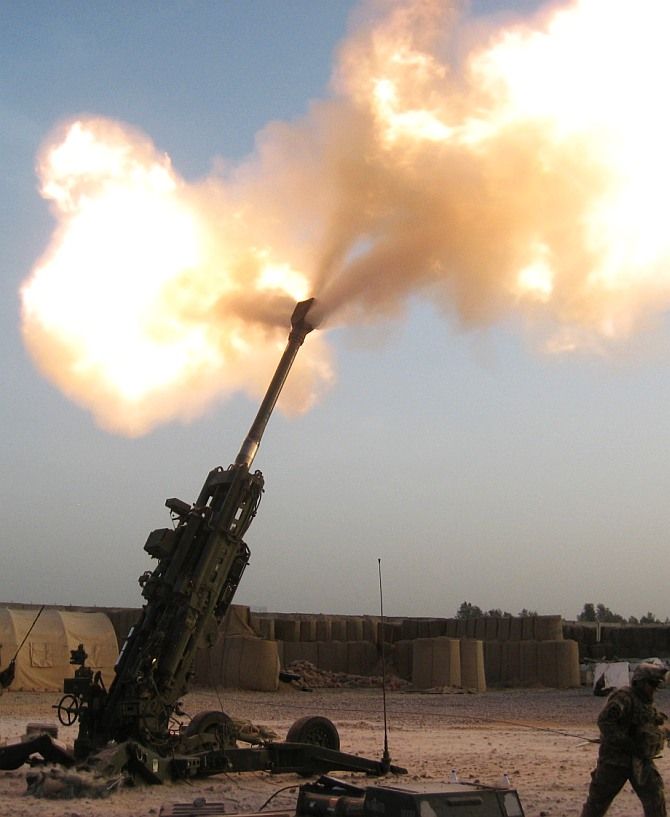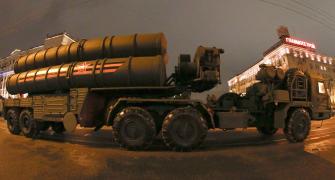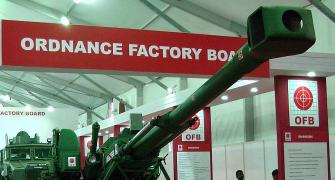In a major milestone, India successfully tests new advanced towed artillery gun system, reports Ajai Shukla.

At 4.30 pm on Tuesday, December 13, in a historic moment for India's artillery programme, an indigenous, fully integrated, 155-millimetre artillery gun fired its first rounds of live ammunition at the Proof and Experimental Establishment (PXE) in Balasore, Odisha.
The 155-mm, 52-calibre gun, dubbed the Advanced Towed Artillery Gun System, has been developed by the Defence R&D Organisation, in partnership with two private sector firms --- the Kalyani Group and Tata Power (Strategic Engineering Division) --- and the Ordnance Factory Board, which is owned by the ministry of defence.
Business Standard learns that Tuesday's firing trials, and a second round of testing on Wednesday, met the specified parameters.
Although extensive testing remains to be carried out in the months ahead, a project manager describes the actual firing as a "major milestone."
The shortage of 155-mm, 52-calibre artillery is widely considered the Indian Army's most worrying shortfall.
Over the preceding 18 years, several international tenders for buying 1,580 towed guns from the international arms market have stalled.
Consequently, no new 155-mm guns have entered the army since the purchase of 410 Bofors howitzers 30 years ago.
With the spectre of Bofors dogging international procurement, the DRDO charged its Pune-based Armament Research & Development Establishment with the ambitious ATAGS project to develop an indigenous towed gun.
"In the ATAGS programme, we are developing two parallel sources to cut the risk of delays. The private sector is extensively involved under the prime minister's 'Make in India' initiative. This would allow us to open two manufacturing lines, to meet the large numbers gun requirements of the services," said Dr S Christopher, the DRDO chairman.
One gun project is being pursued by Tata Power (SED), while the other is working in parallel under the Kalyani Group.
The OFB and Bharat Forge are making the barrels.
Going by specifications, the ATAGS is a world-beater. Its 'extended range, base-bleed' ammunition has a range of 45 kilometres --- more than any 155-mm, 52 calibre gun in service.
ATAGS also has an 'all-electric drive', which is more reliable than conventional hydraulic drives, and improves reaction time and accuracy.
With each ATAGS likely to be priced at Rs 15 crore to Rs 18 crore (Rs 150 million to Rs 180 million), the contract for building 1,580 towed guns would add up to more than Rs 25,000 crore (Rs 250 million).
In war, most soldiers are killed or wounded by artillery fire, which is usually fired from 20 to 30 kilometres away.
When an enemy position is to be attacked, artillery is used to pulverise it so that one's own tanks and infantry soldiers easily over-run it, with minimal hand-to-hand fighting.
India has about 264 artillery regiments, each having 21 guns (including reserves). Many regiments currently deploy lighter, 105-mm 'field guns,' but the army plans to make 155-mm its basic gun, since its heavier shell causes more enemy casualties.
If even 150 of India's artillery regiments are converted to 155-mm guns, that would require 3,150 guns --- twice what was earlier tendered, adding up to about Rs 50,000 crore (Rs 500 million).
On November 25, Defence Minister Manohar Parrikar told Parliament that the ATAGS was one of the DRDO's 'mission mode' projects. He said the ATAGS was to have been completed by September 2015, but the date had been extended to March 2017.
In addition, the artillery-starved army has several other gun procurements in hand.
The OFB used manufacturing blueprints supplied by the Swedish company, Bofors, with the controversial 1986 purchase of 410 FH-77 howitzers, to develop an indigenous 155-mm, 45-calibre gun.
A higher calibre denotes a longer barrel and, consequently, a longer range.
Upgrading the 39-calibre Bofors into the 45-calibre Dhanush has increased the gun's range from 27 kilometres to 35 kilometres (with enhanced range ammunition).
On August 5, the defence minister told Parliament that an indent for 114 Dhanush guns had been placed with the OFB.
Analysts believe that if these guns satisfy the army, the order could increase to as many as 400 guns.
Separately, New Delhi has signed a contract with Washington for 145 ultralight guns of 155-mm, 39-calibre, built by BAE Systems in the US, the defence minister told Parliament on December 2.
In November 2014, the MoD sanctioned 814 mounted gun systems (MGS) for an estimated Rs 15,750 crore (Rs 157.75 million). Tenders are also out for 100 tracked (self-propelled) guns; and 180 wheeled (self-propelled) guns.
All these are 155-mm, 52-calibre guns.
Towed guns are employed in plains and foothills.
Tracked (self-propelled) guns are mounted on armoured vehicles to support high-mobility tank formations.
Wheeled (self-propelled) guns are for fast-moving, non-armoured formations.
The MGS is a regular 155-millimetre gun fitted onto a high mobility vehicle, allowing it to move faster and start firing quicker than a conventional towed gun.










